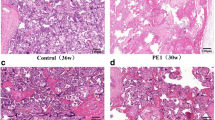Abstract
Endoplasmic reticulum (ER) stress has recently been identified as an important process involved in the pathology of pre-eclampsia (PE). Calreticulin (CRT) is an important ER resident protein which participates in the regulation of intracellular Ca2+ homeostasis, cell adhesion, and cell apoptosis. In order to clarify the role of this protein in normal human pregnancy and in PE, this study has examined the expression of CRT in pre-eclamptic placenta compared with control placenta. The expression of CRT mRNA and protein was elevated in the pre-eclamptic placentas in comparison with control placentas. Furthermore, the expression level was related to the severity of symptoms experienced by PE patients. Therefore, this study aimed to identify the biological characteristics of the CRT gene in trophoblast cells. A CRT-expressing vector was transfected into the JEG-3 human choriocarcinoma cell line. Investigations showed that both proliferation and invasion were inhibited and apoptosis was promoted by CRT expression in JEG-3 cells. These data suggest that augmentation of CRT in the placenta may induce cell apoptosis and impair the invasion of extravillous trophoblast cells, thus leading to shallow placentation in PE.





Similar content being viewed by others
References
Brown, M. A., Hague, W. M., Higgins, J., et al. (2000). The detection, investigation and management of hypertension in pregnancy: Executive summary. Australian and New Zealand Journal of Obstetrics and Gynaecology, 40, 133–138.
Acien, P., Lloret, G., & Lloret, M. (1990). Perinatal morbidity and mortality in pregnancy hypertensive disorders: Prognostic value of the clinical and laboratory findings. International Journal of Gynaecology and Obstetrics, 32, 229–235.
Redman, C. W., & Sargent, I. L. (2005). Latest advances in understanding preeclampsia. Science, 308, 1592–1594.
Roberts, J. M., & Gammill, H. S. (2005). Preeclampsia: Recent insights. Hypertension, 46, 1243–1249.
Burton, G. J., Yung, H. W., Cindrova-Davies, T., & Charnock-Jones, D. S. (2009). Placental endoplasmic reticulum stress and oxidative stress in the pathophysiology of unexplained intrauterine growth restriction and early onset preeclampsia. Placenta, 30, 43–48.
Gold, L. I., Eggleton, P., Sweetwyne, M. T., Van Duyn, L. B., Greives, M. R., Naylor, S. M., et al. (2010). CRT: Non-endoplasmic reticulum functions in physiology and disease. FASEB J, 24, 665–683.
Pal, S., Wu, J., Murray, J. K., Gellman, S. H., Wozniak, M. A., Keely, P. J., et al. (2006). An antiangiogenic neurokinin-B/thromoboxane A2 regulatory axis. Journal of Cell Biology, 174, 1058–1074.
Sato, Y., Fujiwara, H., Higuchi, T., Yoshioka, S., Tatsumi, K., Maeda, M., et al. (2002). Involvement of dipeptidyl peptidase IV in extravillous trophoblast invasion and differentiation. Journal of Clinical Endocrinology and Metabolism, 87, 4287–4296.
Michalak, M., Corbett, E. F., Mesaeli, N., Nakamura, K., & Opas, M. (1999). Calreticulin: One protein, one gene, many functions. Biochemical Journal, 344, 281–292.
Gu, V. Y., Wong, M. H., Stevenson, J. L., Crawford, K. E., Brennecke, S. P., & Gude, N. M. (2008). Calreticulin in human pregnancy and pre-eclampsia. Molecular Human Reproduction, 14, 309–315.
Maria, P. M., Victor, S. M., Monica, K., Juan, C. C., & Cecilia, L. V. (2007). Leptin promotes cell proliferation and survival of trophoblastic cells. Biology of Reproduction, 76, 203–210.
Gelebart, P., Opas, M., & Michalak, M. (2005). Calreticulin, a Ca2+-binding chaperon of the endoplasmic reticulum. International Journal of Biochemistry and Cell Biology, 37, 260–266.
Nakamura, K., Bossy-Wetzel, E., Burns, K., et al. (2000). Changes in endoplasmic reticulum luminal environment affect cell sensitivity to apoptosis. Journal of Cell Biology, 150, 731–740.
Pinton, P., Ferrari, D., Rapizzi, E., et al. (2001). The Ca2+ concentration of the endoplasmic reticulum is a key determinant of ceramide-induced apoptosis: Significance for the molecular mechanism of Bcl-2 action. EMBO Journal, 20, 2690–2701.
Rauch, F., Prud’homme, J., Arabian, A., et al. (2000). Heart, brain and body wall defects in mice lacking calreticulin. Experimental Cell Research, 256, 105–111.
Kageyama, K., Ihara, Y., Goto, S., et al. (2002). Overexpression of calreticulin modulates protein kinase B/Akt signaling to promote apoptosis during cardiac differentiation of cardiomyoblast H9c2 cells. Journal of Biological Chemistry, 277, 19225–19264.
Luo, J. Y., Qiao, F. Y., & Yin, X. H. (2011). Hypoxia induces FGF2 production by vascular endothelial cells and alters MMP9 and TIMP1 expression in extravillous trophoblasts and their invasiveness in a cocultured model. The Journal of Reproduction and Development, 57, 84–91.
Wu, M., Massaeli, H., Durston, M., & Mesaeli, N. (2007). Differential expression and activity of matrix metalloproteinase-2 and -9 in the calreticulin deficient cells. Matrix Biology, 26, 463–472.
Palei, A. C., Sandrim, V. C., Cavalli, R. C., & Tanus-Santos, J. E. (2008). Comparative assessment of matrix metalloproteinase (MMP)-2 and MMP-9, and their inhibitors, tissue inhibitors of metalloproteinase (TIMP)-1 and TIMP-2 in pre-eclampsia and gestational hypertension. Clinical Biochemistry, 41, 875–880.
Cohen, M., Wuillemin, C., Irion, O., & Bischof, P. (2010). Role of decidua in trophoblastic invasion. Neuroendocrinology Letters, 31, 193–197.
Acknowledgments
This study was supported by grants from the Key Project of Medical Science and Technology Development Foundation, Nanjing Department of Health (ZKX08003 and YKK10035), and the Nanjing Medical Science and Technique Development Foundation.
Author information
Authors and Affiliations
Corresponding authors
Additional information
Zhonghua Shi and Wenwen Hou have contributed equally to this study.
Rights and permissions
About this article
Cite this article
Shi, Z., Hou, W., Hua, X. et al. Overexpression of Calreticulin in Pre-eclamptic Placentas: Effect on Apoptosis, Cell Invasion and Severity of Pre-eclampsia. Cell Biochem Biophys 63, 183–189 (2012). https://doi.org/10.1007/s12013-012-9350-5
Published:
Issue Date:
DOI: https://doi.org/10.1007/s12013-012-9350-5




